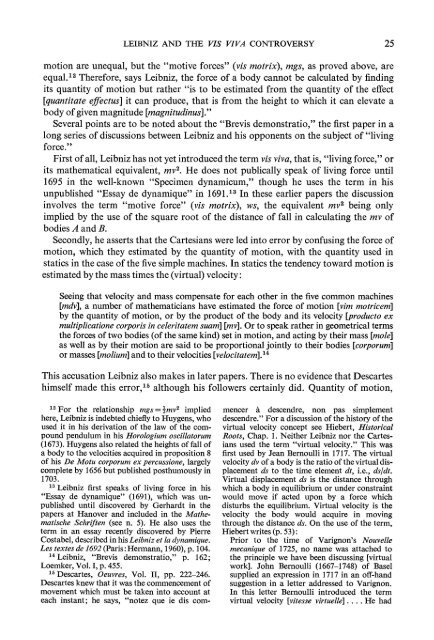Leibniz and the Vis Viva Controversy
Leibniz and the Vis Viva Controversy
Leibniz and the Vis Viva Controversy
Create successful ePaper yourself
Turn your PDF publications into a flip-book with our unique Google optimized e-Paper software.
LEIBNIZ AND THE VIS VIVA CONTROVERSY 25<br />
motion are unequal, but <strong>the</strong> "motive forces" (vis motrix), mgs, as proved above, are<br />
equal.12 Therefore, says <strong>Leibniz</strong>, <strong>the</strong> force of a body cannot be calculated by finding<br />
its quantity of motion but ra<strong>the</strong>r "is to be estimated from <strong>the</strong> quantity of <strong>the</strong> effect<br />
[quantitate effectus] it can produce, that is from <strong>the</strong> height to which it can elevate a<br />
body of given magnitude [magnitudinus]."<br />
Several points are to be noted about <strong>the</strong> "Brevis demonstratio," <strong>the</strong> first paper in a<br />
long series of discussions between <strong>Leibniz</strong> <strong>and</strong> his opponents on <strong>the</strong> subject of "living<br />
force."<br />
First of all, <strong>Leibniz</strong> has not yet introduced <strong>the</strong> term vis viva, that is, "living force," or<br />
its ma<strong>the</strong>matical equivalent, mV2. He does not publically speak of living force until<br />
1695 in <strong>the</strong> well-known "Specimen dynamicum," though he uses <strong>the</strong> term in his<br />
unpublished "Essay de dynamique" in 1691.13 In <strong>the</strong>se earlier papers <strong>the</strong> discussion<br />
involves <strong>the</strong> term "motive force" (vis motrix), ws, <strong>the</strong> equivalent mV2 being only<br />
implied by <strong>the</strong> use of <strong>the</strong> square root of <strong>the</strong> distance of fall in calculating <strong>the</strong> mv of<br />
bodies A <strong>and</strong> B.<br />
Secondly, he asserts that <strong>the</strong> Cartesians were led into error by confusing <strong>the</strong> force of<br />
motion, which <strong>the</strong>y estimated by <strong>the</strong> quantity of motion, with <strong>the</strong> quantity used in<br />
statics in <strong>the</strong> case of <strong>the</strong> five simple machines. In statics <strong>the</strong> tendency toward motion is<br />
estimated by <strong>the</strong> mass times <strong>the</strong> (virtual) velocity:<br />
Seeing that velocity <strong>and</strong> mass compensate for each o<strong>the</strong>r in <strong>the</strong> five common machines<br />
[mdv], a number of ma<strong>the</strong>maticians have estimated <strong>the</strong> force of motion [vim motricem]<br />
by <strong>the</strong> quantity of motion, or by <strong>the</strong> product of <strong>the</strong> body <strong>and</strong> its velocity [producto ex<br />
multiplicatione corporis in celeritatem suam] [mv]. Or to speak ra<strong>the</strong>r in geometrical terms<br />
<strong>the</strong> forces of two bodies (of <strong>the</strong> same kind) set in motion, <strong>and</strong> acting by <strong>the</strong>ir mass [mole]<br />
as well as by <strong>the</strong>ir motion are said to be proportional jointly to <strong>the</strong>ir bodies [corporum]<br />
or masses [molium] <strong>and</strong> to <strong>the</strong>ir velocities [velocitatem].14<br />
This accusation <strong>Leibniz</strong> also makes in later papers. There is no evidence that Descartes<br />
himself made this error,15 although his followers certainly did. Quantity of motion,<br />
12 For <strong>the</strong> relationship mgs = 1mv2 implied mencer a descendre, non pas simplement<br />
here, <strong>Leibniz</strong> is indebted chiefly to Huygens, who descendre." For a discussion of <strong>the</strong> history of <strong>the</strong><br />
used it in his derivation of <strong>the</strong> law of <strong>the</strong> com- virtual velocity concept see Hliebert, Historical<br />
pound pendulum in his Horologium oscillatorum Roots, Chap. 1. Nei<strong>the</strong>r <strong>Leibniz</strong> nor <strong>the</strong> Cartes-<br />
(1673). Huygens also related <strong>the</strong> heights of fall of ians used <strong>the</strong> term "virtual velocity." This was<br />
a body to <strong>the</strong> velocities acquired in proposition 8 first used by Jean Bernoulli in 1717. The virtual<br />
of his De Motu corporum ex percussione, largely velocity dv of a body is <strong>the</strong> ratio of <strong>the</strong> virtual discomplete<br />
by 1656 but published posthumously in placement ds to <strong>the</strong> time element dt, i.e., ds/dt.<br />
1703.<br />
Virtual displacement ds is <strong>the</strong> distance through<br />
13 <strong>Leibniz</strong> first speaks of living force in his which a body in equilibrium or under constraint<br />
"Essay de dynamique" (1691), which was un- would move if acted upon by a force which<br />
published until discovered by Gerhardt in <strong>the</strong> disturbs <strong>the</strong> equilibrium. Virtual velocity is <strong>the</strong><br />
papers at Hanover <strong>and</strong> included in <strong>the</strong> Ma<strong>the</strong>- velocity <strong>the</strong> body would acquire in moving<br />
matische Schriften (see n. 5). He also uses <strong>the</strong> through <strong>the</strong> distance ds. On <strong>the</strong> use of <strong>the</strong> term,<br />
term in an essay recently discovered by Pierre Hiebert writes (p. 53):<br />
Costabel, described in his <strong>Leibniz</strong> et la dynamique. Prior to <strong>the</strong> time of Varignon's Nouvelle<br />
Les textes de 1692 (Paris: Hermann, 1960), p. 104. mecanique of 1725, no name was attached to<br />
14 <strong>Leibniz</strong>, "Brevis demonstratio," p. 162; <strong>the</strong> principle we have been discussing [virtual<br />
Loemker, Vol. I, p. 455.<br />
work]. John Bernoulli (1667-1748) of Basel<br />
15 Descartes, Oeuvres, Vol. II, pp. 222-246. supplied an expression in 1717 in an off-h<strong>and</strong><br />
Descartes knew that it was <strong>the</strong> commencement of suggestion in a letter addressed to Varignon.<br />
movement which must be taken into account at In this letter Bernoulli introduced <strong>the</strong> term<br />
each instant; he says, "notez que ie dis com- virtual velocity [vitesse virtuelle] .... He had
















